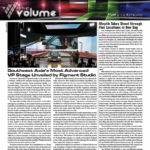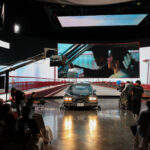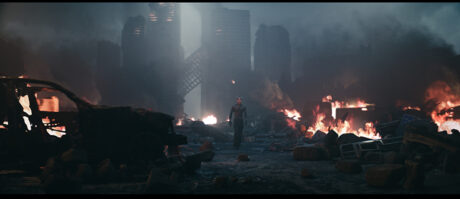
Brompton Technology Helps SVP Expand Creative Horizons
Based in Los Angeles, Synapse Virtual Production (SVP) is an immersive entertainment collective composed of industry-leading creatives and technicians across film and television, advertising, music videos, live events, broadcast, esports, and more. Blending their artistic instincts and technical expertise, the Synapse team specializes in virtual production with a creative-first approach. From the company’s inception, Synapse has relied on Brompton Technology’s LED video processors to help facilitate their cutting-edge virtual production projects. Synapse’s Chief Technology Officer, Geoff Knight, explained: “Coming from a background in live events, I’ve been very familiar with Brompton for years, and know first-hand how excellent and reliable their processors are. Virtual production is so exciting right now because the talent pool is converging from all these different areas, and there’s a robust shared knowledge base for Brompton that we can utilize.”
In early 2023, the Synapse team constructed a temporary pop-up LED volume for hands-on R&D and production work while they planned and built out their permanent facility, which just opened on the campus of Los Angeles Center Studios. One of the projects that Synapse worked on during this time was the music video for Jackson Wang’s Cruel, directed by Synapse’s Chief Creative Officer, and well-respected music video director and VFX artist, Rich Lee. Known for his award-winning work with artists such as Billie Eilish, Lana Del Rey, Rihanna, and Eminem, Lee is no stranger to high concept productions and pushing the boundaries of visual effects. But his utilizing virtual production for Cruel surpassed the team’s high expectations, allowing them to create and capture a digital dystopian world all in-camera.
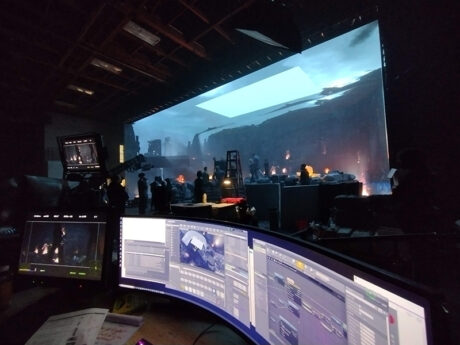
“The concept for Cruel was incredibly ambitious and it turned out to be a very impressive effort in terms of execution and scope, especially with tight timelines for prep and shooting,” shared Christopher Probst, ASC, Chief Innovation Officer at Synapse. “Rich and I had worked on a music video a few years ago with a similar post-apocalyptic look, which we shot on location with a lot of practical elements augmented with VFX, and it was a huge challenge. For Cruel, we were able to capture everything in the LED volume over just two 10-hour days of shooting—a timeframe that’s virtually unheard of for a music video. The shoot went flawlessly and we couldn’t believe the quality of the visuals we were getting in-camera.”
Cruel is set inside a sprawling, nightmarish post-apocalyptic environment; a burning, urban wasteland, full of decay, ruined skyscrapers, massive fires, upturned cars, tons of rubble and a massive industrial throne room at the base of a derelict nuclear power plant. With only two weeks to prep, and another two weeks for post, the traditional options of shooting on location or use of a green screen were problematic. For a location shoot, they would have needed to find an apocalyptic-looking location full of rubble and debris and even then, they would have to augment that footage with complex VFX work. Also, it needed to be a night shoot, which was scheduled during the height of summer, when the nights were incredibly short. Second, lighting up large areas of a practical location at night—and with practical pyro effects—is expensive. The second option of green screen, while offering lighting and schedule control, has the disadvantage that every shot becomes a vfx shot. The budget and the timeframe to delivery made that a no-go option.
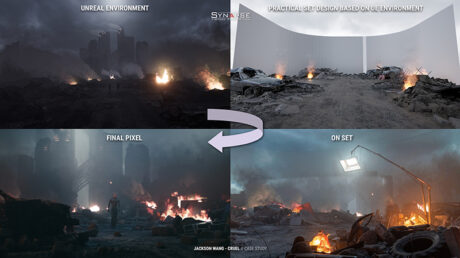
Shooting on the volume created by SVP was the solution. Virtual production allowed the team to stay in one physical location for the duration of the shoot and have control over the shooting conditions. With the freedom they were now afforded creatively the video would have the elaborate scope and dynamic energy the concept promised. The incredibly fast and skilled Synapse Visual Art Department (VAD) team created the two large purpose-built virtual location assets using Unreal Engine in less than a week. This allowed them to spend the rest of prep period testing and helping the physical art department home in on exactly what needed to be created practically to sell the illusion. Since they were shooting the entire video In-Camera and the smoke, fire and large set pieces were all virtual, they did not have to worry about shot length, shooting handheld, or shot count. There was no keying, no roto, no locked-off shots to simplify for vfx and no greenscreen spill.
As noted, to set the scene for the video shoot, the Synapse team created virtual environments in Unreal Engine and integrated them with practical foreground elements on the LED stage. Working in the pop-up volume Synapse created, the space utilized nine Brompton Tessera SX40 processors, powering the 60-foot-wide LED volume at 4K and 60 frames per second. The Brompton processors were particularly advantageous in two areas: the ability to facilitate multi-camera shooting via the Tessera’s Frame Remapping feature and maximizing the panel bit depth via Dark Magic to ensure the best possible color quality, even in low light.
Probst commented, “This environment in particular was at the lower end of the lumen value, so having Brompton’s video processing be able to articulate all those nuances in the grayscale and capture that level of detail was really impressive. What Brompton is doing to improve low light performance is really exciting and expands the possibilities for what can be filmed using virtual production.”
A benefit to shooting content, like Cruel, on a Virtual Production stage with Unreal Engine driven environments displayed on the LED volume screens is the creative freedom it offers while filming. With the digital backdrop already on set, Lee and Probst had an unlimited number of shots with which the team could improvise and discover happy accidents. They could even rearrange elements of the digital backdrop at the touch of a button. “You’re able to improvise,” adds Probst. “The artists are inspired by the environment. They would look around and go, ‘wow, what if I jumped off of this?’ Or ‘I’d love to grab this prop.’ They’re actually responding to and being enveloped into the environment in a way that is wholly different to working in a green-screen limbo. The talent really feel as if they are in this world. It feels real and tangible. There wasn’t a need to imagine a post-apocalyptic hellscape that was going to be done later in post.”
Synapse’s approach to virtual production allowed Cruel to stay on-budget and on-schedule, while at the same time creating a rich, cinematic world that would have otherwise been completely unachievable otherwise due to budget and time constrains. One sequence of the video particularly highlights the benefit of shooting Cruel using virtual production. For the climactic dance battle, the demon queen of the apocalyptic world lifts Wang high into the air. This would traditionally require the performers to be lifted up on a wire, which was not an option on the 25’ tall stage. The team instead built a rotating turntable for the performers to stand on and then with a handheld camera shot the actors as the turntable spun, with the Unreal Engine operators moving the digital environment down, making it appear as if the talent was rising up in the air. To achieve this effect, they first calculated exactly how many revolutions per minute the turntable would need to complete and then they matched the Unreal Engine environment’s movements accordingly. This unique solution resulted in a more convincing effect that saved both time and money.
With the video essentially entirely shot in-camera, on-set, with only a few VFX enhancements to add glowing eyes and a soul-sucking smoke effect needed in post-production, the choice of a VP shoot was certainly correct for Jackson Wang’s well-received Cruel music video. In fact, the artist again turned to Synapse Virtual Production and director Rich Lee to bring his next single, Come Alive to life, and again utilizing in-camera visual effects captured live on set. This time the team constructed a stunning looking Unreal Engine-based derelict virtual carnival environment that literally comes alive.
As Synapse opens the doors to its permanent home in Los Angeles, the team is looking forward to experimenting with the next generation of virtual production technology that is about to come online. Knight commented, “It’s incredible what we’ve been able to achieve with the existing technology, so as we get our hands on Brompton’s new G1 receiver cards and the next-generation LED panels, I think it will blow everything we’ve done so far out of the water. I can’t wait to look back in a few years and see how much things have evolved.”
This story was sourced from content of Brompton Technology; Synapse Virtual Production; and Unreal Engine. Learn more about what they all offer at www.synapsevp.com , www.unrealengine.com/en-US , and www.bromptontech.com.

Nikon Creates’ New Heiwajima Stage
Nikon Creates Studio, a new subsidiary of Nikon Corporation, has recently unveiled its brand-new Heiwajima Stage, a multifunctional shooting facility created with the support of Global Vision Multimedia (GVM). Located at Nikon Creates’ imaging complex in Tokyo, Japan, the stage features the latest technology, including volumetric video recording systems and a large LED volume of Absen technology for virtual production (VP) setups, driven by Brompton Technology LED processing. The studio’s close proximity to Haneda Airport makes it easily accessible for domestic and international clients. It also allows for easy transportation of equipment, such as lighting and special machinery, enabling efficient shooting for productions of various sizes.
Heiwajima Stage will serve as an epicenter for cultivating innovative ideas in collaboration with a new generation of creators. Its impressive LED setup consists of a 10.4m wide by 4.2m high main LED wall made up of Absen AX1.5 PRO, plus a height adjustable ceiling for ambient lighting, comprising Absen JP4 LED panels which measures 6m wide by 4.2m deep. The studio also features two movable 1.8m wide by 3m high Absen LED side screens, again used for ambient lighting. The entire setup is powered by four Brompton 4K Tessera SX40 LED processors, along with 14 Tessera 10G data distribution units.
With the cutting-edge technology like Brompton LED processing, the new studio can facilitate the promotion of next-generation visual content. “The SX40 is the pinnacle of tech specifications, which is why we chose it when we started discussions about the project. It also has a proven track record in VP and XR studios around the globe,” says Kazuhiro Hirano, President at Nikon Creates. “It was an easy and obvious decision to use Brompton LED processing. The SX40 is an exceptional LED video processor that enables precise control over color reproduction and tone adjustments, allowing you to capture the image exactly as you want it.” Elijah Ebo, Brompton Director of APAC Operations, notes, “Our Tessera SX40 is a top choice for LED video processing in VP and XR, and we work incredibly hard to ensure our products consistently meet and exceed our clients’ expectations. We are honored that Nikon Creates and GVM have put their trust in us for such a future-oriented facility.”
The balance of the system includes a disguise vx4+, a vx2, and four rxII units, employing ICVFX as the primary shooting method. The input is compatible with 12G-SDI, and the input/output is optimized for high-resolution shooting. “We utilize Stype’s Redspy as the tracking system, which delivers exceptional performance across all aspects, and naturally, everything is aligned through synchronization signals, guaranteeing its functionality within the studio,” adds Kazuhiro Hirano. “Furthermore, by employing a motion control system called BOLT, we can achieve distinctive camera work, and there is also a volumetric video studio that can be integrated to foster innovative video expressions.”
GVM’s teams are known for designing versatile system environments through a combination of hardware engineering and software. For Heiwajima Stage, its technical designers developed a multidisciplinary language that encompassed several key elements, including video projection, show control, lighting design, interactive media and specialized sound systems, creating an inherent symbiosis between a project’s creative vision and its practical realization. “Our technical teams understand the seamless integration required to cultivate innovative environments that bring our clients’ brands and visions to life,” says Etsushi Oka, Sales Director at GVM. “We like to plan as far in advance as possible when working on projects like Heiwajima Stage, integrating technical layers one by one to ensure there are no unexpected surprises down the road.”
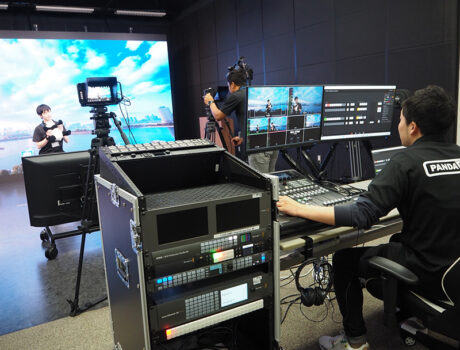
PANDASTUDIO.TV’s Choice for new Workflow at Streaming Studio
Blackmagic Design announced that PANDASTUDIO.TV Inc. is utilizing a range of Blackmagic Design products for a new streaming workflow, including ATEM Television Studio HD8 ISO live production swticher and Blackmagic Studio Camera 4K Pro G2, at Panda Studio Odaiba in Tokyo, which opened last year. PANDASTUDIO.TV is engaged in various video related businesses, including studio and video equipment rentals, live streaming, systems integration and studio construction. The company operates six studios in Japan and has been using numerous Blackmagic Design products for many years. Last year, the company opened Panda Studio Odaiba, a large-scale video streaming studio covering approximately 9,257 square feet in the Aqua City Odaiba, a large shopping complex in Odaiba, Tokyo.
Panda Studio Odaiba consists of four studios, a versatile lobby with an impressive 300” LED screen, and waiting rooms. Studio 1 is designed for virtual production using green screen chroma key, Studio 2 is for virtual production using a large LED wall as a background, Studio 3 is used for interviews and product PR videos, and Studio 4 is used for seminars with large audiences. Shoma Tezuka, from the company’s Solution Business Division, explained, “The concept of Panda Studio Odaiba is that the studio is so large that you can freely shoot anywhere. There are four studios and except for Studio 1 most of the equipment is rack mounted and can be used anywhere, so even the waiting rooms can be used as a studio. For rack mounting, Blackmagic Design products are suitable as they are compact. You can come in empty handed and start streaming or recording your content right away.”
Blackmagic Design creates high quality video editing products, digital film cameras, color correctors, video converters, video monitoring, routers, live production switchers, disk recorders, waveform monitors and real time film scanners for the feature film, post production and television broadcast industries. At Panda Studio Odaiba, Blackmagic Design products serve as the primary equipment in Studio 2 and Studio 4, with multiple Blackmagic Studio Camera 4K Pro G2s installed. Studio 2 has a choice of live production switchers, including the ATEM 2 M/E Constellation HD, ATEM 1 M/E Production Studio 4K, and ATEM Mini Extreme ISO, depending on the application. Studio 4, on the other hand, uses an ATEM Television Studio HD8 ISO as its main switcher. PANDA STUDIO ODAIBA also features Smart Videohub 12G 40×40 routers, ATEM Camera Control Panels, HyperDeck Studio 4K Pro and HyperDeck Studio HD Mini recorders, Blackmagic Studio Converters, ATEM Microphone Converters, Teranex AV standards converter, UltraStudio 4K Mini capture and playback devices, Blackmagic Web Presenter 4K streaming solutions, and ATEM Streaming Bridge converter.

Tezuka says, “While our customers primarily use our studio for streaming, customers from production divisions of TV stations also come to our studio to shoot content for their stations’ YouTube channels. We have some options for switchers and cameras from a few manufacturers, depending on the studio, but we use Videohub routers, HyperDeck recorders, and Web Presenter 4K encoders in various parts of the entire studio.” Orio Nakamura of PANDASTUDIO.TV commented, “When you build your system entirely with Blackmagic products, you can control all the cameras and recorders. By mounting them in a rack, you have an all-in-one system for shooting, streaming, and recording, which is very cost effective. The Studio Camera can be connected with just a single LAN cable when used with the Studio Converter. This makes it very easy to take the equipment to different locations, which suits this studio’s concept.”
In conclusion, Nakamura spoke about the ATEM Television Studio HD8 ISO, noting, “This switcher is perfect for seminars. It has built in network storage, so when the seminar is over, for example, we can immediately upload the ISO recording data to the cloud, such as Dropbox. Once the upload is complete, the footage can be edited with DaVinci Resolve by staff in our other studios. We also have Blackmagic Cloud Pods in our other studios, so we can sync them via Dropbox and use a local copy of the footage. And with Blackmagic Cloud, collaboration works between our studios, allowing us to be even more efficient.”
